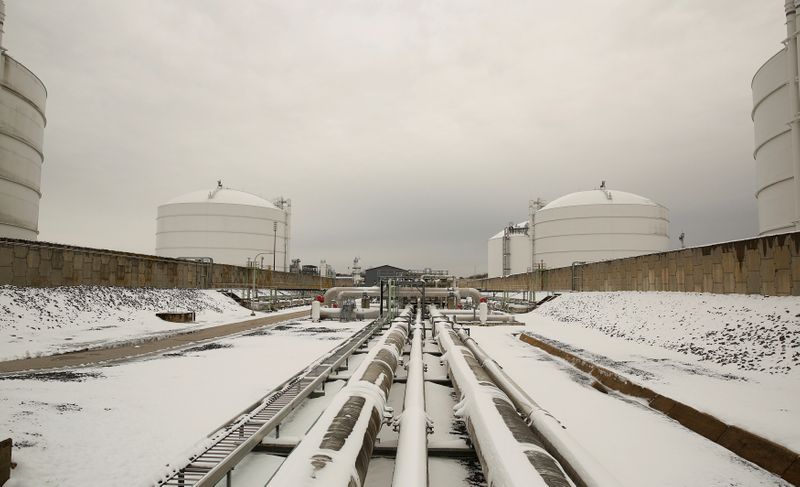LONDON (Reuters) – U.S. natural gas prices have tumbled since the start of November as persistent mild weather has caused inventories to remain high rather than drawing down in line with seasonal trends.
Futures prices for gas delivered to Henry Hub in January 2021 have fallen to just over $2.40 per million British thermal units, down from almost $3.50 at the end of October.
And the six-month calendar spread between futures contracts with deliveries in January and July has slumped into a contango (forward prices above spot prices) of almost 13 cents, from a backwardation (spot above forwards) of over 40 cents.
Lower futures prices will encourage maximum gas burn by U.S. power producers, mostly at the expense of coal, while the contango will pay for higher stocks to be carried over until next summer.
The Lower 48 states are now roughly a quarter of the way through the winter heating season, based on average population-weighted heating demand over three decades between 1981 and 2010.
So far this heating season, temperatures across the Lower 48 have been warmer than normal, and heating demand has been 12% below the long-term average, according to the Climate Prediction Center.
As a result, working gas stocks have remained broadly flat in recent weeks, rather than drawing down as usual at this time of year (“Weekly natural gas storage report”, Energy Information Administration, Dec. 3).
Stocks are now 294 billion cubic feet (8%) above the five-year average, up from a surplus of 191 bcf (5%) at the end of October (https://tmsnrt.rs/2K7Ku68).
Earlier in the heating season, traders anticipated a colder winter, pushing prices up to encourage gas-fired power producers to conserve fuel and incentivise more use of coal.
Forecasts of a colder winter were based, in part, on the emergence of La Nina conditions in the central and eastern Pacific this autumn.
But with temperatures staying relatively warm, and a surplus of gas re-emerging, prices have fallen to ensure gas generators reverse the temporary loss of market share to coal.
In the seven days ending Dec. 6, gas-fired generators supplied around 36% of all electricity consumption, while coal units supplied 23%, with both shares roughly similar to the same point in 2019.
The recent fall in prices should encourage gas generators to run for more hours in December and January, reducing surplus gas stocks.
At the same time, pressure on gas prices will continue to discourage production increases, helping rebalance the market from the other side.
According to oilfield services company Baker Hughes, the number of rigs drilling for gas has remained broadly unchanged since August, in contrast to the number of rigs drilling for oil, which has increased by a third.
Increased oil drilling will increase the volume of associated gas produced as a by-product, but the low level of gas-directed drilling will at least limit the total increase in gas output.
Related columns:
– U.S. gas market rebalances after low prices curb glut (Reuters, Nov. 17)
– Warm U.S. winter puts coal-fired power plants in deep freeze (Reuters, Feb. 6)
– Plunging U.S. gas prices intensify squeeze on coal (Reuters, Jan. 21)
(Editing by Mark Potter)













